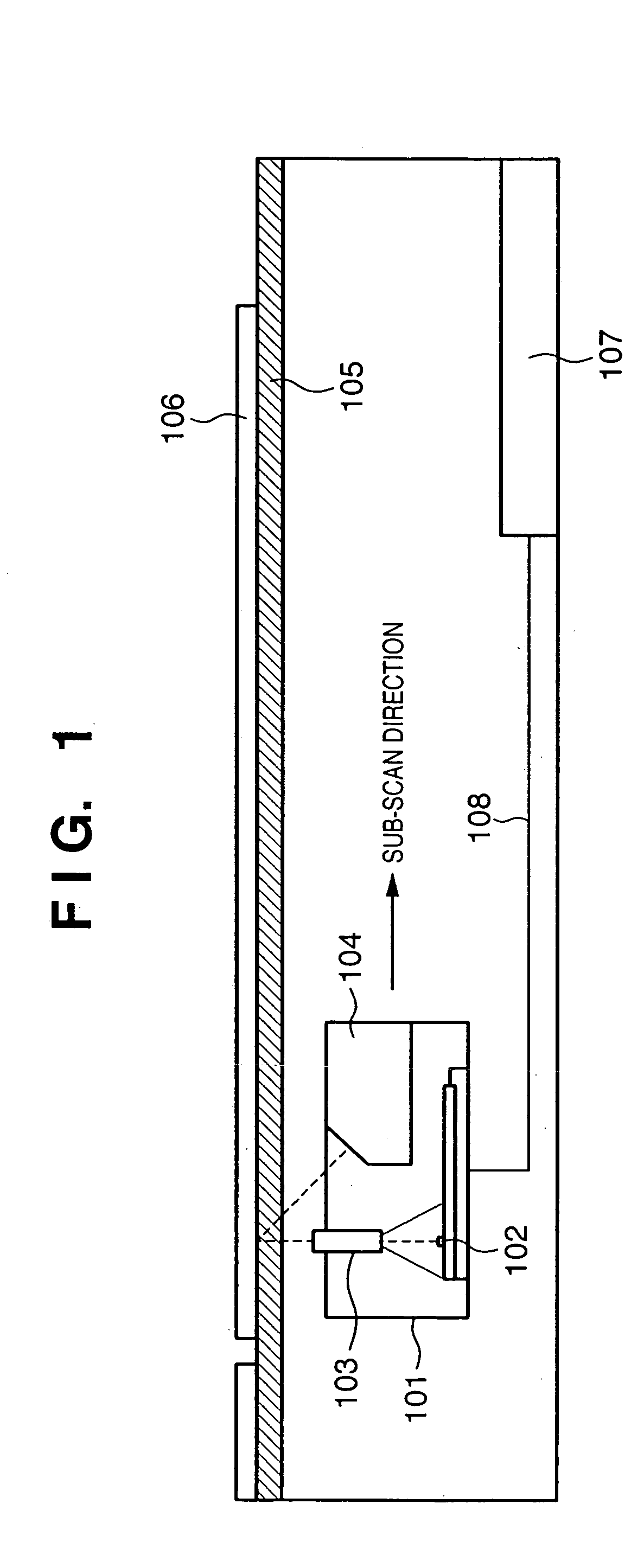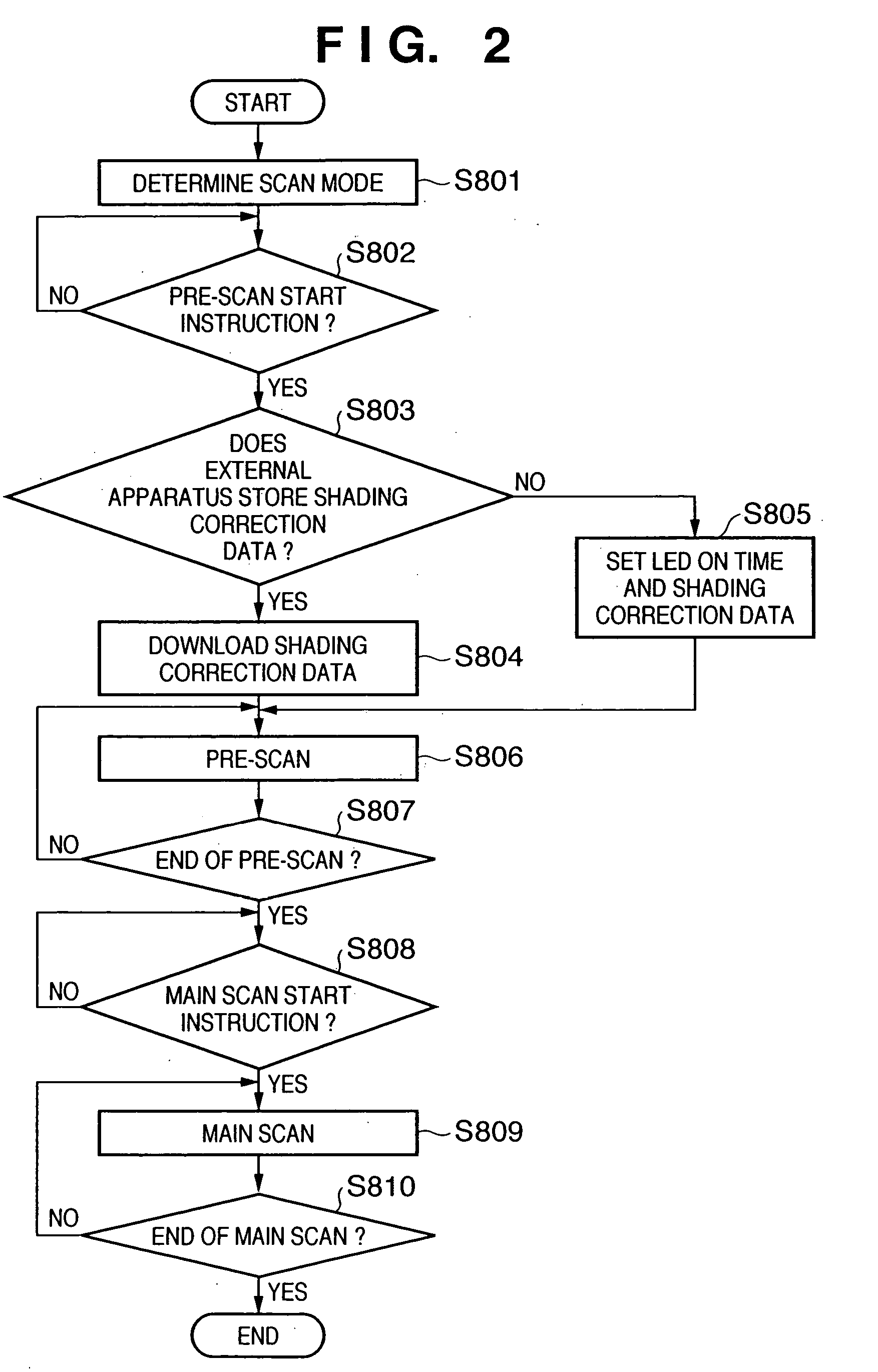Image scanning device and its control method
a technology for scanning devices and document images, applied in the direction of picture signal generators, solid-state device signal generators, instruments, etc., can solve the problems of poor color reproducibility of emerald systems, small light-receiving area of each extraction unit, and inability to achieve high color reproducibility. , to achieve the effect of simple arrangement and faithful color reproduction
- Summary
- Abstract
- Description
- Claims
- Application Information
AI Technical Summary
Benefits of technology
Problems solved by technology
Method used
Image
Examples
first embodiment
[0036]FIG. 1 is a schematic sectional view of a document scanning device (image scanner) of this embodiment.
[0037] Referring to FIG. 1, reference numeral 101 denotes a contact image sensor unit (to be abbreviated as CIS hereinafter). Reference numeral 104 denotes an optical waveguide light source in which a red LED (R-LED), green LED (G-LED), blue LED (B-LED), and an emerald LED (emerald color will be referred to as E color hereinafter, and the emerald LED will be referred to as E-LED hereinafter) are arranged at the end portion of the waveguide which is elongated in a direction perpendicular to the plane of page (main scan direction), and which guides light emitted by each LED in the main scan direction by internal reflection to linearly irradiate a document 106 to be scanned on a document table glass (platen glass) 105 with that light.
[0038] Light reflected by the document surface is received by a monochrome image sensor 102 via a lens array 103. Light-receiving elements of the ...
second embodiment
[0083] In the first embodiment, the color correction processes in the three-color scan mode and four-color scan mode are executed on the image scanning device side. Alternatively, the scanned R, G, and B or R, G, B, and E component data may be output to the host computer, which may execute the correction processes. When the correction processes are done on the host computer side, that correction function can be added to an image scanner driver which runs on the host computer. As a result, the edit processes that can obtain the effects of the above embodiment can be made without modifying a normal image processing application.
[0084] An implementation example of the color correction processes by a scanner driver on the PC 300 side will be explained hereinafter as the second embodiment.
[0085] The structure of the image scanning device is the same as that shown in FIG. 7. However, when the 32-bit multi-valued mode is set, the image scanning device directly outputs 8-bit data of R, G, ...
third embodiment
[0107] A case will be explained below wherein the transmitting document illumination unit 210 (see FIG. 7) is used. The transmitting document illumination unit 210 includes four LEDs, i.e., R, G, B, and E LEDs if it is applied to the first embodiment.
[0108] Nowadays, a four-layered silver halide film to which a color sensitive layer sensitive to emerald is added in addition to red, green, and blue color sensitive layers is commercially available, as disclosed in Japanese Patent Laid-Open No. 2003-84402. Since the transmitting document illumination unit 210 of this embodiment includes four, R, G, B, and E light sources (LEDs) as in the above description, it scans a transmitting document of such four-layered silver halide film, thus obtaining a scanned image with higher color reproducibility.
[0109]FIG. 11 is a sectional view when the transmitting document illumination unit 210 is connected to the interface 208 of this device via a cable 230. In FIG. 11, reference numeral 220 denotes...
PUM
 Login to View More
Login to View More Abstract
Description
Claims
Application Information
 Login to View More
Login to View More - R&D
- Intellectual Property
- Life Sciences
- Materials
- Tech Scout
- Unparalleled Data Quality
- Higher Quality Content
- 60% Fewer Hallucinations
Browse by: Latest US Patents, China's latest patents, Technical Efficacy Thesaurus, Application Domain, Technology Topic, Popular Technical Reports.
© 2025 PatSnap. All rights reserved.Legal|Privacy policy|Modern Slavery Act Transparency Statement|Sitemap|About US| Contact US: help@patsnap.com



